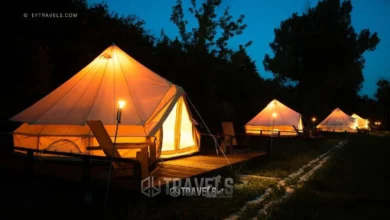What to Wear When Hiking? The Ultimate Hiking Clothes Guide
So, you're ready to swap the concrete jungle for the great outdoors and immerse yourself in the wilderness? Fantastic! But before you venture out into the unpredictable world of trails and treks, let's talk about something that will play a crucial role in your adventure: what to wear when hiking. Find out what to wear when hiking with our comprehensive clothing guide. Elevate your outdoor experience with the best hiking attire recommendations.
Table Of Contents
- What to Wear When Hiking?
- How to Choose the Best Hiking Clothes
- What Should You Wear for Summer Hiking?
- Essential Hiking Gear and Clothing for Different Weather Conditions
- Choosing the Right Base Layers and Hiking Bottoms
- Tips for Selecting the Ideal Hiking Outfit
- FAQs:
- Q: What are the essential clothing items to wear when hiking?
- Q: Can I wear cotton clothing when hiking?
- Q: What should I wear on a hike during the summer months?
- Q: What are the most important accessories to consider when hiking?
- Q: What type of footwear is best for hiking?
- Q: What should I wear for hiking in cold weather?
- Q: Are there specific considerations for what underwear to wear when hiking?
- Q: What should I avoid wearing when hiking?
- Q: What clothing is better for hiking in the rain?
- Q: How should I prepare for weather changes when hiking?
What to Wear When Hiking?
When it comes to hiking, wearing the right clothing is essential for a comfortable and enjoyable outdoor experience. Whether you're embarking on a day hike or a multi-day trek, choosing the appropriate hiking attire can make all the difference. From selecting the best hiking shoes to choosing the ideal base layers, here's a comprehensive guide to help you dress for success on the trails.
This isn't just about looking good for Instagram photos atop scenic peaks (although that never hurts). It's about comfort, safety, and overall enjoyment. Your choice of hiking clothes can be the difference between an unforgettable journey into nature or a discomfort-filled ordeal that leaves blisters instead of beautiful memories. So buckle up as we dive into your ultimate hiking clothes guide!
How to Choose the Best Hiking Clothes
Factors to Consider When Selecting Hiking Apparel

Before you hit the hiking trail, it's important to consider several factors when choosing your hiking apparel. Weather conditions, terrain, and the duration of your hike are crucial aspects to take into account.
- Opt for moisture-wicking fabrics that offer breathability and comfort, especially for longer treks.
- Additionally, consider the weight and packability of your clothing to ensure you can easily carry them in your backpack.
Choosing the Right Hiking Shoes
One of the most critical pieces of gear for any hiker is the hiking shoes. Your choice of footwear can significantly impact your hiking experience. Select hiking boots or shoes that provide ample ankle support and traction, particularly for uneven terrains. Look for options with durable outsoles and waterproofing for added protection in wet conditions.
Importance of Proper Hiking Socks
Hiking socks are often an overlooked aspect of hiking attire, yet they play a vital role in preventing blisters and providing cushioning and support for your feet. Opt for moisture-wicking, cushioned hiking socks that offer warmth and comfort. Consider the length of the socks based on your preference, whether it's crew-length or over-the-calf for added protection.
What Should You Wear for Summer Hiking?
Best Clothing Materials for Summer Hiking
Choosing the right clothing materials for summer hiking is crucial for keeping cool and comfortable in warm weather. Lightweight and breathable fabrics, such as moisture-wicking synthetic blends or merino wool, are ideal choices to wick away sweat and allow for quick drying. Additionally, opt for clothing with built-in UV protection to shield your skin from the sun's harmful rays.
Essential Accessories for Hiking in Hot Weather

Accessorizing for summer hiking is equally important to protect yourself from the heat. Consider wearing a wide-brimmed hat or a cap with a neck flap to shield your face and neck from direct sunlight. Don't forget to pack a pair of reliable sunglasses with UV protection to safeguard your eyes from glare and harmful UV rays.
Tips for Dressing for Comfort in Summer
For added comfort during summer hikes, choose loose-fitting and light-colored clothing to allow for airflow and reflect the sun's rays. Opt for moisture-wicking, quick-drying hiking shorts and shirts to keep sweat at bay. Applying sunscreen and staying hydrated are essential elements to ensure your safety and well-being while hiking in hot conditions.
Essential Hiking Gear and Clothing for Different Weather Conditions
Preparing for Cold Weather Hiking
When preparing for cold-weather hiking, layering is key to staying warm and insulated. Start with a moisture-wicking base layer to keep sweat away from your skin, then add insulating layers such as fleece or down jackets for warmth. Invest in a quality pair of winter hiking pants and a waterproof, insulated jacket to shield yourself from cold temperatures, wind, and precipitation.
Tips for Dressing for Rainy Hikes
For hiking in rainy conditions, it's crucial to have the right rain gear to keep you dry and comfortable. A reliable rain jacket with sealed seams and waterproof zippers is essential to fend off moisture. Pair it with waterproof rain pants for full protection. Additionally, consider wearing a brimmed hat or a cap with a rain flap to shed rain away from your face and maintain visibility on the trail.
Best Clothing Choices for Hot and Sunny Conditions

When hiking in hot and sunny conditions, lightweight and breathable clothing is key. Opt for moisture-wicking and quick-drying fabrics to keep you cool and dry. Consider wearing convertible hiking pants that can be zipped off into shorts for added versatility. Don't forget to wear a wide-brimmed hat and apply sunscreen to shield yourself from the sun's intense heat and UV rays.
Choosing the Right Base Layers and Hiking Bottoms
Benefits of Quality Base Layers for Hiking
Investing in quality base layers is essential for maintaining comfort and regulating body temperature during hikes. Look for moisture-wicking and breathable base layers made of merino wool or synthetic fabrics to keep you dry and odor-free. Base layers with thermal properties are also beneficial for colder conditions, providing insulation without adding extra bulk.
Maximizing Comfort with the Right Hiking Pants or Shorts
Choosing the right hiking pants or shorts can significantly impact your mobility and comfort on the trails. Opt for versatile and durable hiking bottoms that offer features such as stretch, articulated knees, and abrasion resistance. Consider the length and fit based on the terrain and weather conditions you'll be encountering during your trek.
Understanding the Importance of Proper Hiking Underwear

Hiking underwear plays a crucial role in preventing chafing and ensuring proper moisture management. Look for moisture-wicking and quick-drying underwear made of performance fabrics to keep you dry and comfortable during your hikes. Seamless construction and flatlock seams can minimize friction and irritation, enhancing your overall comfort on the trail.
Tips for Selecting the Ideal Hiking Outfit
Suggestions for Creating the Ultimate Hiking Ensemble
When assembling your hiking outfit, prioritize functionality and comfort without sacrificing style. Consider layering your clothing to easily adjust to changing weather conditions. Opt for versatile pieces that can be mixed and matched, offering flexibility and adaptability on the trail. Choose clothing with practical features such as ventilation, pockets, and adjustable closures to enhance your overall hiking experience.
Finding the Perfect Balance of Style and Function in Hiking Attire
Finding the right balance of style and function in your hiking attire is possible with the wide array of high-performance and stylish hiking apparel available today. Look for clothing that not only meets your technical requirements but also aligns with your personal style preferences. Seek out brands that prioritize both performance and design, allowing you to feel confident and fashionable while enjoying the great outdoors.
Key Considerations When Choosing Hiking Clothes

When selecting hiking clothes, it's important to consider factors such as comfort, durability, and versatility. Choose clothing that allows for a full range of motion, provides protection from the elements, and offers functional features such as moisture-wicking, quick-drying, and UV protection. Prioritize quality and performance to ensure your hiking clothes can withstand the demands of the trails.
FAQs:
Q: What are the essential clothing items to wear when hiking?
A: Essential clothing items to wear when hiking include moisture-wicking base layers, a comfortable hiking shirt, durable hiking shorts or leggings, and sturdy hiking footwear.
Q: Can I wear cotton clothing when hiking?
A: It's best to avoid wearing cotton clothing when hiking as it retains moisture and can lead to discomfort and chafing. Opt for moisture-wicking and quick-drying fabrics instead.
Q: What should I wear on a hike during the summer months?
A: In the summer, it's advisable to wear lightweight and breathable clothing, such as moisture-wicking shirts, shorts, or convertible hiking pants to stay cool and comfortable.
Q: What are the most important accessories to consider when hiking?
A: Important hiking accessories to consider include a sun hat, sunglasses, a hydration pack or water bottle, sunscreen, insect repellent, and a lightweight, packable rain jacket in case of unexpected weather changes.
Q: What type of footwear is best for hiking?
A: For hiking, it's recommended to wear sturdy hiking boots or trail shoes with good traction and ankle support to provide stability and protection on various terrains.
Q: What should I wear for hiking in cold weather?
A: In cold weather, it's important to layer clothing, including a moisture-wicking base layer, insulating mid-layers, a waterproof and windproof outer layer, warm hiking socks, gloves, and a beanie to stay warm and dry.
Q: Are there specific considerations for what underwear to wear when hiking?
A: When hiking, choose moisture-wicking and breathable underwear to prevent chafing and maintain comfort during your hike.
Q: What should I avoid wearing when hiking?
A: Avoid wearing cotton clothing, denim, and non-breathable materials that can lead to discomfort, chafing, and moisture retention. Also, steer clear of footwear that isn't suitable for hiking.
Q: What clothing is better for hiking in the rain?
A: For hiking in the rain, it's advisable to wear waterproof and breathable rain gear, including a rain jacket, rain pants, and waterproof hiking boots to stay dry and comfortable.
Q: How should I prepare for weather changes when hiking?
A: When hiking, be prepared for weather changes by packing or wearing layers that can be easily added or removed to adapt to varying temperatures and conditions.






